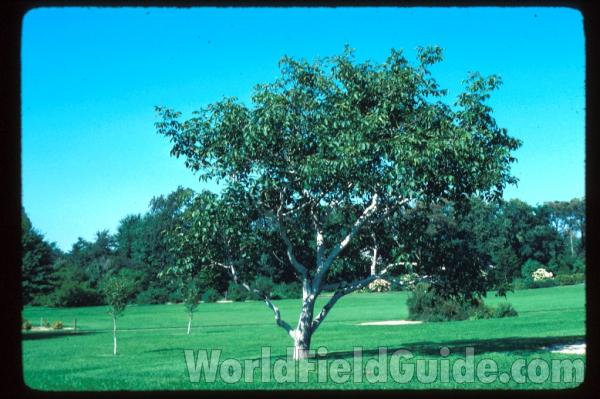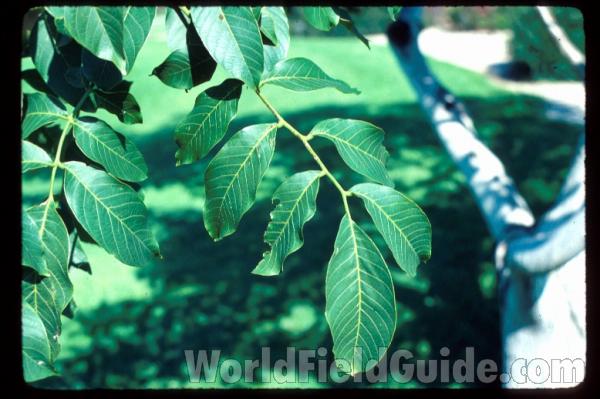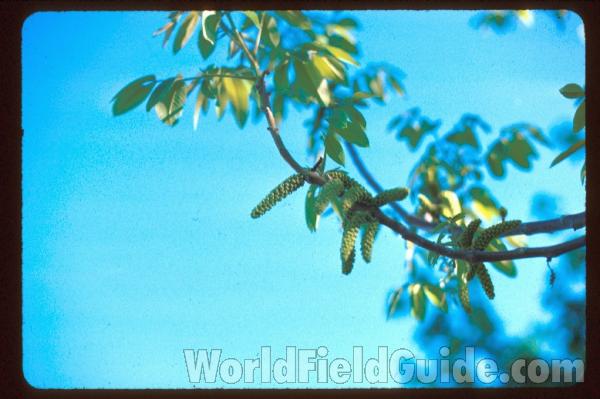SPECIES INFO
Common or English Walnut (Juglans regia) is a native of Persia and the Himalayas but has been cultivated in Europe and Rome since the time of Tiberius. The tree grows to sixty to ninety feet tall in ideal conditions. There are typically five to seven leaflets on each compound leaf.
The fresh nut is considered one of the best nuts for eating and is also used to make oils useful in cooking as well as in the manufacture of paints. The timber is very valuable and used in the manufacture of gunstocks and cabinetmaking. The leaves are said to deter clothes moths.Walnut (Genus Juglans) contains about 15-20 species of trees native to North and South America and Eurasia characterized by their compound leaves with pairs of opposite lanceolate leaflets. Six of those species are native to the United States, and several others (including the English walnut, Juglans regia) are considered established here. The wood of several species is considered very valuable. The fruit is contained in a larger husk that is not easily opened.
Juglandaceae Family is the sole family in the Juglandales Order. It contains many species of trees with very valuable wood. The hickory and walnut genus are both in this family.
Following is a list of the thirteen hickory species found in the United States (* those 7 discussed here):
*Carya alba (=tomentosa) - Mockernut - East USA
Carya aquatica - Water Hickory - South USA
Carya carolinae-septentionalis - Southern Shagbark - SE USA
*Carya cordiformis - Bitternut - East USA
Carya floridana - Scrub Hickory- SE USA
*Carya glabra (3 varieties) - Pignut - East USA
var. glabra (=microcarpa) - Small Fruited - East USA
var. megacarpa(=austrina)
var. hirsuta(=leiodermis)- Swamp Hickory - Louisiana
*Carya illinoinensis - Pecan - SC USA
*Carya lacinosa - Shellbark - Central USA
Carya myristiciformis - Nutmeg Hickory - Local S USA
*Carya ovalis - Sweet Pignut - East USA
*Carya ovata - Shagbark - East USA
Carya pallida - Sand Hickory - SE USA
Carya texana - Black - SC USA
Following is a list of the nine species of Walnuts found in the United States: ( * = those 5 discussed here):
*Juglans ailanthifolia - Japan - Introduced
Juglans californica - California - S. Calif.
*Juglans cinerea - Butternut - North USA
Juglans hindsii - Hinds Walnut - Local Calif.
Juglans jamaicensis - -
Juglans major - Arizona Walnut- SW US & Mex.
*Juglans microcarpa - Little Walnut - Texas
*Juglans nigra - Black Walnut - E. USA
*Juglans regia - English Walnut - Introduced
Juglandales Order contains the Walnuts and the Hickories. The ovary is one-celled, and the flowers are unisexual. (The male flowers of walnuts, for example, are found in catkins, and the female flowers in terminal clusters.)
Dicots (Dicotyledoneae Class) are the predominant group of vascular plants on earth. With the exception of the grasses (Monocots) and the Conifers (Gymnosperms), most of the larger plants that one encounters are Dicots. Dicots are characterized by having a seed with two outer shell coverings.
Some of the more primitive Dicots are the typical hardwood trees (oaks, birches, hickories, etc). The more advanced Dicots include many of the Composite (Aster) Family flowers like the Dandelion, Aster, Thistles, and Sunflowers. Although many Monocots reach a very high degree of specialization, most botanists feel that the Dicots represent the most advanced group of plants.
Seed plants (Phylum Embryophyta) are generally grouped into one large phylum containing three major classes: the Gymnosperms, the Monocots, and the Dicots. (Some scientists separate the Gymnosperms into a separate phylum and refer to the remaining plants as flowering plants or Angiospermae.)
For North American counts of the number of species in each genus and family, the primary reference has been John T. Kartesz, author of A Synonymized Checklist of the Vascular Flora of the United States, Canada, and Greenland (1994). The geographical scope of his lists include, as part of greater North America, Hawaii, Alaska, Greenland, Puerto Rico, and the Virgin Islands.
Kartesz lists 21,757 species of vascular plants comprising the ferns, gymnosperms and flowering plants as being found in greater North America (including Alaska, Hawaii, Greenland, Puerto Rico and the Virgin Islands.
There are estimates within the scientific world that about half of the listed North American seed plants were originally native with the balance being comprised of Eurasian and tropical plants that have become established.
Plant kingdom contains a large variety of different organisms including mosses, ferns, and seed plants. Most plants manufacture their energy from sunlight and water. Identification of many species is difficult in that most individual plants have characteristics that have variables based on soil moisture, soil chemistry, and sunlight.
Because of the difficulty in learning and identifying different plant groups, specialists have emerged that study only a limited group of plants. These specialists revise the taxonomy and give us detailed descriptions and ranges of the various species. Their results are published in technical journals and written with highly specialized words that apply to a specific group.
On the other hand, there are the nature publishers. These people and companies undertake the challenging task of trying to provide easy to use pictures and descriptions to identify those species.





